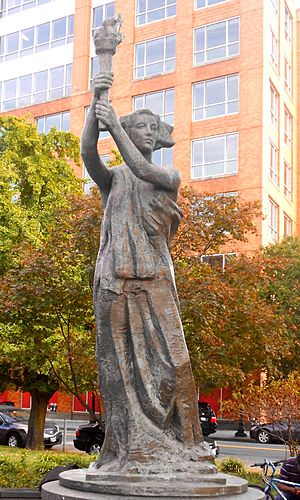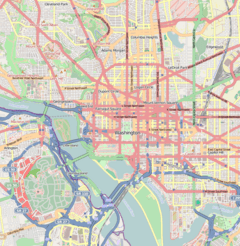Victims of Communism Memorial facts for kids

Goddess of Democracy replica
|
|
| Coordinates | 38°53′54″N 77°00′43″W / 38.8984°N 77.0120°W |
|---|---|
| Location | Washington, D.C. |
| Designer | Thomas Marsh |
| Type | Statue |
| Beginning date | September 27, 2006 |
| Opening date | June 12, 2007 |
The Victims of Communism Memorial is a special place in Washington, D.C. It is located near Union Station and the U.S. Capitol.
This memorial remembers "more than one hundred million victims of communism." The group that built it, the Victims of Communism Memorial Foundation, wants to make sure that "the history of communist tyranny will be taught to future generations." This means they want people to learn about the harm caused by communist governments.
President George W. Bush officially opened the memorial on June 12, 2007. This date was important because it was 20 years after President Ronald Reagan's famous "tear down this wall" speech at the Berlin Wall.
The memorial has a large bronze statue that is ten-foot (3 m) tall. It is a copy of the Goddess of Democracy statue. Students created the original statue during the Tiananmen Square protests of 1989 in China. The artist who designed the memorial and the statue is Thomas Marsh. He also helped create a copy of the Goddess of Democracy in Chinatown, San Francisco in 1994.
The words on the memorial say:
- (front) To the more than one hundred million victims of communism and to those who love liberty
- (rear) To the freedom and independence of all captive nations and peoples
Contents
How the Memorial Was Created
The idea for the memorial started with a special law. In 1993, a bill called H.R. 3000 was supported by lawmakers like Dana Rohrabacher and Tom Lantos. It was also supported by Senators Claiborne Pell and Jesse Helms.
This bill was approved by everyone and signed into law by President Bill Clinton. This law allowed the memorial to be built. Important people like Lev E. Dobriansky and Grover Norquist also helped make it happen.
It took some time to build the memorial. So, the permission to build it was extended until 2007. The Victims of Communism Memorial Foundation was in charge of raising money and planning the first steps.
In 2005, the design for the monument was approved. After raising over US$825,000, construction began. The groundbreaking ceremony, which is when building officially starts, was held on September 27, 2006.
The Dedication Ceremony
The memorial was officially opened on June 12, 2007. Many people from different countries attended the ceremony. These were people who had experienced difficulties under Communist governments.
Some of the guests included Vietnamese poet Nguyen Chi Thien and Chinese activist Harry Wu. Lithuanian journalist Nijolė Sadūnaitė was also there.
During the ceremony, President George W. Bush spoke about those who suffered. He mentioned people from Ukraine, Russia, Lithuania, and other places. He talked about those who were harmed by hunger, forced labor, or violence under communist rule.
President Bush said, "We'll never know the names of all who perished." But he added that at this memorial, "communism's unknown victims will be consecrated to history and remembered forever." He explained that the memorial helps us honor their lives and memory.
He also compared communism to the threat of terrorism. He said both are "murderous ideologies that despise freedom." They try to control everything and stop people from disagreeing.
Other ceremonies have been held at the memorial since it opened. These events continue to remember those who suffered under communist rule.
Why Some People Criticized the Memorial
The memorial, especially the statue, received some criticism. The Chinese embassy was not happy about it. They said the memorial was an "attempt to defame China." This means they felt it was trying to make China look bad.
The Chinese foreign ministry said the U.S. was using "Cold War" ideas. They felt the U.S. was getting involved in China's internal matters. They made a formal protest about the memorial.
Professor Andrei Tsygankov from San Francisco State University also saw the statue as a sign of old "Cold War" thinking. He felt it brought back old rivalries between countries.
Professor Shi Yinhong from the People's University of China thought the monument was not appropriate. He said that bad things have happened in many countries, not just socialist ones. He questioned why there isn't a monument to victims of capitalism.
A week after the memorial opened, Russian President Vladimir Putin also responded. He pointed out that Russia had not used nuclear weapons on civilians. He also mentioned that Russia had not dropped as many bombs on small countries as some others.
A Russian politician named Gennady Zyuganov called the memorial a "clumsy propaganda attempt." He said it was meant to distract from what he called "crimes of U.S. imperialism." He also questioned how an American president could open such a monument given other events in history.
In Ukraine, there was even a response to open a museum about "American imperialism." This museum would focus on things like the repression of Native Americans and slavery. It would also highlight U.S. actions in other countries.
Images for kids
-
George W. Bush speaking at the memorial's dedication ceremony
See Also
 In Spanish: Monumento a las Víctimas del Comunismo (Washington D. C.) para niños
In Spanish: Monumento a las Víctimas del Comunismo (Washington D. C.) para niños





